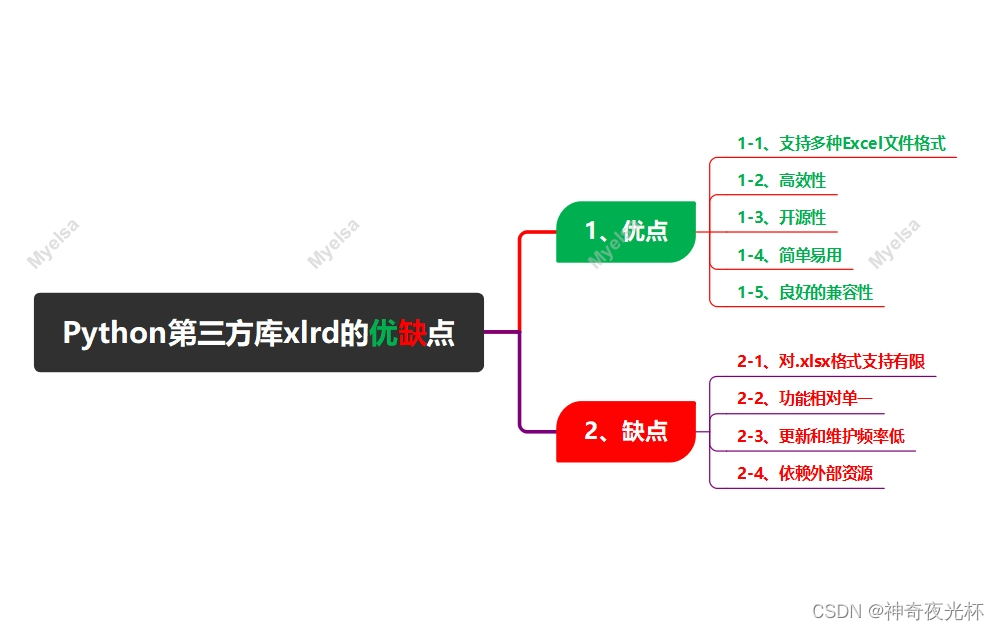目录
一、xlrd库的由来
二、xlrd库优缺点
1、优点
1-1、支持多种Excel文件格式
1-2、高效性
1-3、开源性
1-4、简单易用
1-5、良好的兼容性
2、缺点
2-1、对.xlsx格式支持有限
2-2、功能相对单一
2-3、更新和维护频率低
2-4、依赖外部资源
三、xlrd库的版本说明
1、xlrd 1.2.0版本
2、xlrd 2.0.1版本
3、xlrd3(非官方名称)
四、如何学好xlrd库?
1、获取xlrd库的属性和方法
2、获取xlrd库的帮助信息
3、用法精讲
3-13、xlrd.book.Book.sheet_by_name方法
3-13-1、语法
3-13-2、参数
3-13-3、功能
3-13-4、返回值
3-13-5、说明
3-13-6、用法
3-14、xlrd.book.Book.sheets方法
3-14-1、语法
3-14-2、参数
3-14-3、功能
3-14-4、返回值
3-14-5、说明
3-14-6、用法
3-15、xlrd.book.Book.sheet_names方法
3-15-1、语法
3-15-2、参数
3-15-3、功能
3-15-4、返回值
3-15-5、说明
3-15-6、用法
3-16、xlrd.book.Book.sheet_by_index方法
3-16-1、语法
3-16-2、参数
3-16-3、功能
3-16-4、返回值
3-16-5、说明
3-16-6、 用法
3-17、xlrd.book.Book.dump方法
3-17-1、语法
3-17-2、参数
3-17-3、功能
3-17-4、返回值
3-17-5、说明
3-17-6、 用法
五、推荐阅读
1、Python筑基之旅
2、Python函数之旅
3、Python算法之旅
4、Python魔法之旅
5、 博客个人主页



在Excel中,通常所说的“情侣键”并非官方术语,而是对某些常用且经常成对出现的快捷键的一种形象化的称呼。其中,最为人熟知和广泛使用的“情侣键”是“Ctrl+C”和“Ctrl+V”。
1、Ctrl+C:这个快捷键的作用是“拷贝”或“复制”。当你在Excel中选中某个单元格、一行、一列或整个工作表的内容后,按下Ctrl+C键,这些内容就会被复制到计算机的剪贴板中,等待下一步的粘贴操作。
2、Ctrl+V:这个快捷键的作用是“粘贴”。在你按下Ctrl+C键将内容复制到剪贴板后,可以通过按下Ctrl+V键将这些内容粘贴到Excel中的另一个位置,这两个操作经常是连续进行的,因此Ctrl+C和Ctrl+V就像一对“情侣”,总是成对出现。
除了这对常见的“情侣键”外,Excel中还有许多其他的快捷键可以帮助用户更高效地完成各种操作。然而,这些快捷键通常并没有像Ctrl+C和Ctrl+V那样形成特定的“情侣”关系。
然而,今天我不再展开介绍“情侣键”,而是要重点推介Python中的“情侣库”,即xlrd和xlwt两个第三方库。
一、xlrd库的由来
xlrd库是一种用于在Python中读取Excel文件的库,它的名称中的"xl"代表Excel,"rd"代表读取,其开发者是John Machin(注:库名字符拆分诠释,只是一种猜测)。
xlrd最初是在2005年开始开发的,是基于Python的开源项目(下载:xlrd库官网下载)。
由于Excel文件在数据处理和分析中的重要性,xlrd库填补了Python在处理Excel文件方面的空白,使得用户可以方便地在Python环境中读取Excel文件的内容,并进行进一步的数据操作和分析。
二、xlrd库优缺点
1、优点
1-1、支持多种Excel文件格式
xlrd库支持多种Excel文件格式,包括`.xls`和`.xlsx`(在旧版本中),这使得无论数据存储在哪种格式的Excel文件中,用户都可以使用xlrd库来读取。
1-2、高效性
xlrd库使用C语言编写,因此其性能非常高,即使面对非常大的Excel文件,xlrd也可以快速地读取其中的数据。
1-3、开源性
xlrd是完全开源的,可以在GitHub等平台上找到其源代码,这使得任何人都可以根据自己的需求对其进行修改和扩展。
1-4、简单易用
xlrd提供了简单直接的API来获取单元格数据、行列数等,使得从Excel文件中读取数据变得简单而高效。
1-5、良好的兼容性
xlrd库适配多种Python版本,包括Python 2.7(不包括3.0-3.3)或Python 3.4及以上版本,这为用户提供了广泛的兼容性选择。
2、缺点
2-1、对.xlsx格式支持有限
在xlrd 1.2.0之后的版本中(大约从2020年开始),xlrd库不再支持`.xlsx`文件格式,这限制了xlrd在新版Excel文件(主要是`.xlsx`格式)上的应用。
2-2、功能相对单一
xlrd库主要专注于从Excel文件中读取数据,而不提供写入或修改Excel文件的功能,这使得在处理需要写入或修改Excel文件的任务时,用户需要结合其他库(如`openpyxl`或`xlwt`)使用。
2-3、更新和维护频率低
由于xlrd库主要关注于读取Excel文件的功能,并且随着`.xlsx`格式的普及,其使用范围逐渐缩小,因此,xlrd库的更新和维护频率可能相对较低。
2-4、依赖外部资源
在某些情况下,xlrd库可能需要依赖外部资源或库来完全发挥其功能,这可能会增加用户在使用xlrd库时的复杂性和不确定性。
总之,xlrd库在读取Excel文件方面具有高效、开源和简单易用等优点,但在对`.xlsx`格式的支持、功能单一以及更新和维护频率等方面存在一些缺点,用户在选择使用xlrd库时需要根据自己的需求进行权衡和选择。

三、xlrd库的版本说明
xlrd库适配的Python版本根据库的不同版本而有所不同。以下是针对几个主要版本的说明:
1、xlrd 1.2.0版本
1-1、适配Python>=2.7(不包括3.0-3.3)或Python>=3.4。
1-2、该版本支持xlsx文件格式,并且是一个广泛使用的版本,因为它能够处理小到中等大小的Excel文件,并且具有较好的性能表现。
2、xlrd 2.0.1版本
2-1、适配Python>=2.7(不包括3.0-3.5)或Python>=3.6。
2-2、该版本不再支持xlsx文件格式,仅支持旧版的xls文件格式,因为在xlrd 2.0版本之后,xlrd移除了对xlsx格式的支持。
3、xlrd3(非官方名称)
xlrd3是xlrd的开源扩展库,提供了对xlsx文件格式的支持,然而,请注意,xlrd3并不是xlrd的官方名称(下载:GitHub - Dragon2fly/xlrd3)。
四、如何学好xlrd库?
1、获取xlrd库的属性和方法
用print()和dir()两个函数获取xlrd库所有属性和方法的列表
# ['Book', 'FILE_FORMAT_DESCRIPTIONS', 'FMLA_TYPE_ARRAY', 'FMLA_TYPE_CELL', 'FMLA_TYPE_COND_FMT', 'FMLA_TYPE_DATA_VAL',
# 'FMLA_TYPE_NAME', 'FMLA_TYPE_SHARED', 'Operand', 'PEEK_SIZE', 'Ref3D', 'XLDateError', 'XLRDError', 'XLS_SIGNATURE',
# 'XL_CELL_BLANK', 'XL_CELL_BOOLEAN', 'XL_CELL_DATE', 'XL_CELL_EMPTY', 'XL_CELL_ERROR', 'XL_CELL_NUMBER', 'XL_CELL_TEXT', 'ZIP_SIGNATURE',
# '__VERSION__', '__builtins__', '__cached__', '__doc__', '__file__', '__loader__', '__name__', '__package__', '__path__',
# '__spec__', '__version__',
# 'biff_text_from_num', 'biffh', 'book', 'cellname', 'cellnameabs', 'colname', 'compdoc', 'count_records', 'decompile_formula',
# 'dump', 'dump_formula', 'empty_cell', 'error_text_from_code', 'evaluate_name_formula', 'formatting', 'formula', 'info',
# 'inspect_format', 'oBOOL', 'oERR', 'oNUM', 'oREF', 'oREL', 'oSTRG', 'oUNK', 'okind_dict', 'open_workbook', 'open_workbook_xls',
# 'os', 'pprint', 'rangename3d', 'rangename3drel', 'sheet', 'sys', 'timemachine', 'xldate', 'xldate_as_datetime', 'xldate_as_tuple', 'zipfile']2、获取xlrd库的帮助信息
用help()函数获取xlrd库的帮助信息
Help on package xlrd:NAMExlrdDESCRIPTION# Copyright (c) 2005-2012 Stephen John Machin, Lingfo Pty Ltd# This module is part of the xlrd package, which is released under a# BSD-style licence.PACKAGE CONTENTSbiffhbookcompdocformattingformulainfosheettimemachinexldateFUNCTIONScount_records(filename, outfile=<_io.TextIOWrapper name='<stdout>' mode='w' encoding='utf-8'>)For debugging and analysis: summarise the file's BIFF records.ie: produce a sorted file of ``(record_name, count)``.:param filename: The path to the file to be summarised.:param outfile: An open file, to which the summary is written.dump(filename, outfile=<_io.TextIOWrapper name='<stdout>' mode='w' encoding='utf-8'>, unnumbered=False)For debugging: dump an XLS file's BIFF records in char & hex.:param filename: The path to the file to be dumped.:param outfile: An open file, to which the dump is written.:param unnumbered: If true, omit offsets (for meaningful diffs).inspect_format(path=None, content=None)Inspect the content at the supplied path or the :class:`bytes` content providedand return the file's type as a :class:`str`, or ``None`` if it cannotbe determined.:param path:A :class:`string <str>` path containing the content to inspect.``~`` will be expanded.:param content:The :class:`bytes` content to inspect.:returns:A :class:`str`, or ``None`` if the format cannot be determined.The return value can always be looked up in :data:`FILE_FORMAT_DESCRIPTIONS`to return a human-readable description of the format found.open_workbook(filename=None, logfile=<_io.TextIOWrapper name='<stdout>' mode='w' encoding='utf-8'>, verbosity=0, use_mmap=True, file_contents=None, encoding_override=None, formatting_info=False, on_demand=False, ragged_rows=False, ignore_workbook_corruption=False)Open a spreadsheet file for data extraction.:param filename: The path to the spreadsheet file to be opened.:param logfile: An open file to which messages and diagnostics are written.:param verbosity: Increases the volume of trace material written to thelogfile.:param use_mmap:Whether to use the mmap module is determined heuristically.Use this arg to override the result.Current heuristic: mmap is used if it exists.:param file_contents:A string or an :class:`mmap.mmap` object or some other behave-alikeobject. If ``file_contents`` is supplied, ``filename`` will not be used,except (possibly) in messages.:param encoding_override:Used to overcome missing or bad codepage informationin older-version files. See :doc:`unicode`.:param formatting_info:The default is ``False``, which saves memory.In this case, "Blank" cells, which are those with their own formattinginformation but no data, are treated as empty by ignoring the file's``BLANK`` and ``MULBLANK`` records.This cuts off any bottom or right "margin" of rows of empty or blankcells.Only :meth:`~xlrd.sheet.Sheet.cell_value` and:meth:`~xlrd.sheet.Sheet.cell_type` are available.When ``True``, formatting information will be read from the spreadsheetfile. This provides all cells, including empty and blank cells.Formatting information is available for each cell.Note that this will raise a NotImplementedError when used with anxlsx file.:param on_demand:Governs whether sheets are all loaded initially or when demandedby the caller. See :doc:`on_demand`.:param ragged_rows:The default of ``False`` means all rows are padded out with empty cells sothat all rows have the same size as found in:attr:`~xlrd.sheet.Sheet.ncols`.``True`` means that there are no empty cells at the ends of rows.This can result in substantial memory savings if rows are of widelyvarying sizes. See also the :meth:`~xlrd.sheet.Sheet.row_len` method.:param ignore_workbook_corruption:This option allows to read corrupted workbooks.When ``False`` you may face CompDocError: Workbook corruption.When ``True`` that exception will be ignored.:returns: An instance of the :class:`~xlrd.book.Book` class.DATAFILE_FORMAT_DESCRIPTIONS = {'xls': 'Excel xls', 'xlsb': 'Excel 2007 xl...FMLA_TYPE_ARRAY = 4FMLA_TYPE_CELL = 1FMLA_TYPE_COND_FMT = 8FMLA_TYPE_DATA_VAL = 16FMLA_TYPE_NAME = 32FMLA_TYPE_SHARED = 2PEEK_SIZE = 8XLS_SIGNATURE = b'\xd0\xcf\x11\xe0\xa1\xb1\x1a\xe1'XL_CELL_BLANK = 6XL_CELL_BOOLEAN = 4XL_CELL_DATE = 3XL_CELL_EMPTY = 0XL_CELL_ERROR = 5XL_CELL_NUMBER = 2XL_CELL_TEXT = 1ZIP_SIGNATURE = b'PK\x03\x04'__VERSION__ = '2.0.1'biff_text_from_num = {0: '(not BIFF)', 20: '2.0', 21: '2.1', 30: '3', ...empty_cell = empty:''error_text_from_code = {0: '#NULL!', 7: '#DIV/0!', 15: '#VALUE!', 23: ...oBOOL = 3oERR = 4oNUM = 2oREF = -1oREL = -2oSTRG = 1oUNK = 0okind_dict = {-2: 'oREL', -1: 'oREF', 0: 'oUNK', 1: 'oSTRG', 2: 'oNUM'...VERSION2.0.1FILEe:\python_workspace\pythonproject\lib\site-packages\xlrd\__init__.py3、用法精讲
3-13、xlrd.book.Book.sheet_by_name方法
3-13-1、语法
sheet_by_name(self, sheet_name):param sheet_name: Name of the sheet required.:returns: A :class:`~xlrd.sheet.Sheet`.
3-13-2、参数
3-13-2-1、self(必须):一个对实例对象本身的引用,在类的所有方法中都会自动传递。
3-13-2-2、sheet_name(必须):一个字符串,表示要检索的工作表的名称。
3-13-3、功能
用于通过工作表名称获取工作表对象。
3-13-4、返回值
3-13-4-1、如果找到了具有给定名称的工作表,则返回该工作表对象(通常是xlrd.sheet.Sheet类型的一个实例)。
3-13-4-2、如果没有找到具有给定名称的工作表,则会抛出一个异常(如xlrd.biffh.XLRDError)。
3-13-5、说明
无
3-13-6、用法
# 13、xlrd.book.Book.sheet_by_name方法
import xlrd
# 打开 Excel 文件
workbook = xlrd.open_workbook('example.xls')
# 通过名称获取工作表
sheet = workbook.sheet_by_name('Sheet1')
# 现在你可以使用 sheet 对象来访问和操作该工作表中的数据3-14、xlrd.book.Book.sheets方法
3-14-1、语法
sheets(self):returns: A list of all sheets in the book.All sheets not already loaded will be loaded.3-14-2、参数
3-14-2-1、self(必须):一个对实例对象本身的引用,在类的所有方法中都会自动传递。
3-14-3、功能
用于获取 Excel 工作簿(Workbook)中的所有工作表(Worksheet)对象。
3-14-4、返回值
返回的是一个Python列表,该列表包含了工作簿中所有工作表对象的引用,每个工作表对象都是xlrd.sheet.Sheet类的实例,代表了Excel文件中的一个工作表。
3-14-5、说明
无
3-14-6、用法
# 14、xlrd.book.Book.sheets方法
import xlrd
# 打开 Excel 文件
workbook = xlrd.open_workbook('example.xls')
# 获取所有工作表对象列表
sheets = workbook.sheets()
# 遍历工作表列表
for sheet in sheets: print(sheet.name) # 打印每个工作表的名称 print(sheet.nrows) # 打印每个工作表的行数 print(sheet.ncols) # 打印每个工作表的列数 # ... 其他操作 ...3-15、xlrd.book.Book.sheet_names方法
3-15-1、语法
sheet_names(self):returns:A list of the names of all the worksheets in the workbook file.This information is available even when no sheets have yet beenloaded.
3-15-2、参数
3-15-2-1、self(必须):一个对实例对象本身的引用,在类的所有方法中都会自动传递。
3-15-3、功能
用于获取 Excel 工作簿(Workbook)中所有工作表(Worksheet)的名称。
3-15-4、返回值
返回的是一个Python列表,该列表包含了工作簿中所有工作表的名称,每个名称都是字符串类型。
3-15-5、说明
无
3-15-6、用法
# 15、xlrd.book.Book.sheet_names方法
import xlrd
# 打开Excel文件
workbook = xlrd.open_workbook('example.xls')
# 获取所有工作表的名称列表
sheet_names = workbook.sheet_names()
# 遍历并打印工作表名称
for name in sheet_names: print(name)3-16、xlrd.book.Book.sheet_by_index方法
3-16-1、语法
sheet_by_index(self, sheetx):param sheetx: Sheet index in ``range(nsheets)``:returns: A :class:`~xlrd.sheet.Sheet`.3-16-2、参数
3-16-2-1、self(必须):一个对实例对象本身的引用,在类的所有方法中都会自动传递。
3-16-2-2、sheetx(必须):一个非负整数,表示工作表的索引号,默认从0开始。
3-16-3、功能
用于通过索引获取Excel工作簿(Workbook)中的工作表(Worksheet)对象。
3-16-4、返回值
返回的是一个xlrd.sheet.Sheet类的实例,代表了Excel文件中的一个工作表。
3-16-5、说明
索引值必须是一个非负整数,并且不能超过工作簿中工作表的总数。如果索引值超出范围,xlrd会抛出一个IndexError异常。
3-16-6、 用法
# 16、xlrd.book.Book.sheet_by_index方法
import xlrd
# 打开Excel文件
workbook = xlrd.open_workbook('example.xls')
# 通过索引获取工作表对象
sheet = workbook.sheet_by_index(0) # 获取第一个工作表,索引从0开始
# 现在你可以使用 sheet 对象来访问和操作该工作表中的数据
print(sheet.name) # 打印工作表的名称
print(sheet.nrows) # 打印工作表的行数
print(sheet.ncols) # 打印工作表的列数3-17、xlrd.book.Book.dump方法
3-17-1、语法
dump(self, f=None, header=None, footer=None, indent=0):param f: open file object, to which the dump is written:param header: text to write before the dump:param footer: text to write after the dump:param indent: number of leading spaces (for recursive calls)3-17-2、参数
3-17-2-1、self(必须):一个对实例对象本身的引用,在类的所有方法中都会自动传递。
3-17-2-2、f(可选):一个打开的文件对象,用于写入转储(dump)内容。
3-17-2-3、header(可选):一个字符串,表示在转储内容之前写入的文本。
3-17-2-4、footer(可选):一个字符串,表示在转储内容之后写入的文本。
3-17-2-5、indent(可选):一个整数,用于指定在输出结构化数据时(如JSON、YAML等)的缩进级别,默认值为0,表示不添加任何缩进。
3-17-3、功能
将某个对象(通常是类实例的某些数据)以特定的格式写入到指定的文件或输出流中。
3-17-4、返回值
不返回任何值(即返回None)。它的主要目的是将数据写入到某个位置,而不是生成一个可以返回的结果。
3-17-5、说明
无
3-17-6、 用法
# 17、xlrd.book.Book.dump方法
import sys
import json
class MyClass:def __init__(self, data):self.data = datadef dump(self, f=None, header="Data Dump", footer="End of Data Dump", indent=2):if f is None:f = sys.stdout # 使用标准输出f.write(header + "\n")# 调用data_to_string方法将self.data转换为字符串f.write(self.data_to_string(indent=indent))f.write(footer + "\n")def data_to_string(self, indent):# 使用json.dumps将self.data转换为格式化的字符串return json.dumps(self.data, indent=indent, ensure_ascii=False)
if __name__ == '__main__':obj = MyClass({"key": "value"})obj.dump(indent=4) # 输出到控制台,并使用4个空格的缩进
# 输出:
# Data Dump
# {
# "key": "value"
# }End of Data Dump
学习笔记(4):线性表)

)










![java中为什么main方法是public static void main(String [] args)](http://pic.xiahunao.cn/java中为什么main方法是public static void main(String [] args))




